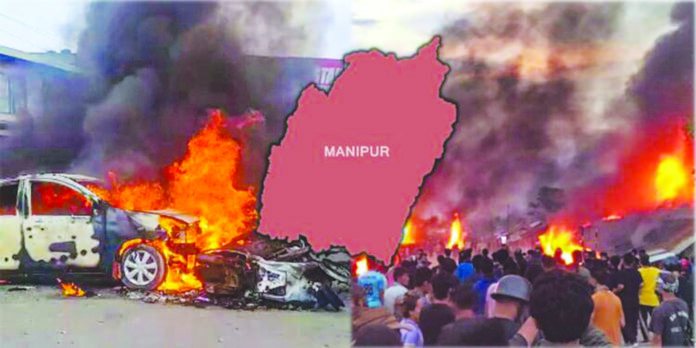The Republic of India has been advertised as the largest state practising democracy in the world and as an advocate of human rights at the international forum. That bluff of India to call itself the protector of democracy and human rights has earned it an international reputation and voice.
However, all these claims could only be true in a parallel world. The story is quite different from the one portrayed at the international level. The streets of Kashmir, Manipur, Nagaland, Assam, and other victimized areas are eyewitness to the majoritarian politics of Bharatiya Janata Party (BJP). The rape victim women, the democide of minorities, and extensive torture and discrimination of Other Backward Classes (OBC), screams of the injustice being held out in a so-called largest democracy and advocate of human rights, but sadly their voices are not loud enough.
Policy of Bluff is a concept used by Hans J. Morgenthau in his book, Politics Among Nations, where he defines the policy of bluff as a tool for states to gain prestige and power. In this policy, a state exaggerates itself to get reputation and perks in the international arena. The Modi regime has successfully executed this bluff of creating India as the largest democracy in this world and not letting any voice against this image in the international media. The BJP Government’s policy has rightly earned them perks and privileges in the shape of a voice at the international forums and huge economic opportunities in the state. Whereas there remains a need to highlight the ground-level problems in Modi-led India.
Being the largest democracy in the world, India must have had public representation at all levels of government but, unfortunately due to the large Hindu population and strong Hindu extremist narrative of BJP, the democracy of India is rather a Hindu Majoritarianism than a democracy. Due to the many extremist Hindu supporters of the BJP, there remains a sense of legitimacy in BJP’s government to have a majoritarian approach in their socio-political landscape.
The second component of democracy remains the protection of human rights without any racial, ethnic, or caste-based discrimination. However, a state having a caste system embedded in its constitution with a discriminated class of OBCs, Scheduled castes, and Scheduled tribes cannot be expected to be the advocate of human rights.
The bluff of being the largest secular democracy and human rights protector by the Indian government has surely earned it prestige at the international level, but the ground reality completely differs. The international community needs to examine the true commitment by India and ensure the principles of democracy and human rights be fulfilled. Although the Manipur incident has been considered by the European Union and the USA, there remains a sufficient difference between weightage of actions and words by the international community.
This caste system has also led to caste-based politics and riots having human rights violations. While the bluff is played at the international level by the Modi regime to be the protector of human rights, the story is parallel within India.
Another bluff from the Indian government is secularism, whereas, in reality, the politics of the BJP stands on the extremist Hindutva narrative. The narrative of the BJP that Hindu identity is Indian identity surely has led to many extremist events in the country with a lot of human rights violations.
The concept of National Citizenship Register (NRC) introduced mainly in the Assam region shows the systemic exploitation and exclusion of as many Muslims as possible. This technique has helped the Modi Government to call Muslims of Assam illegal immigrants to cast out them from the voting procedure and exclude them from India. This shows the actual politics of India, which is based on Hindu superiority, with the absence of any secularism in their approach.
Another example is the socio-political and economic injustice in the Indian Occupied Kashmir (IOK) after the abrogation of Articles 370 and 35A of the Indian Constitution. The so-called protectors of human rights had been the cruellest human rights violators, with the atrocities carried out in IOK. Mass killings, rapes, and unbearable torture is what the people of IOK have been facing for four years.
The communal riots of Gujarat in 2002, also known as the Gujarat Massacre, explains the level of brutality and extremism flourishing on the streets of India. Large number of Hindu mobs targeted the Muslim community resulting in thousands of killings, women being sexually tortured, raped and murdered. This incident was one of the most brutal depictions of human rights violations with targeted killings, arson, looting, rape, and brutal torture. The present Prime Minister of the Republic of India, the n the Chief Minister of Gujarat, was highly criticized by the international community, but this neither changed the extremist mindset of the people nor did the communal based killings and human rights violations stop.
Manipur, a northeastern state of India, is also currently in the grip of communal violence and destroyed by the extremist Hindutva ideology of the Modi regime. The Christian Kuki community is being tortured and humiliated by the Hindu Meitei community. The basic violence is because of the caste system as well as religious superiority. The latest video of two women being dragged into the streets naked and then raped shows the level of exploited extremist mindset of the Hindu mobs, especially the BJP and RSS.
The bluff of being the largest secular democracy and human rights protector by the Indian government has surely earned it prestige at the international level, but the ground reality completely differs. The international community needs to examine the true commitment by India and ensure the principles of democracy and human rights be fulfilled. Although the Manipur incident has been considered by the European Union and the USA, there remains a sufficient difference between weightage of actions and words by the international community.























